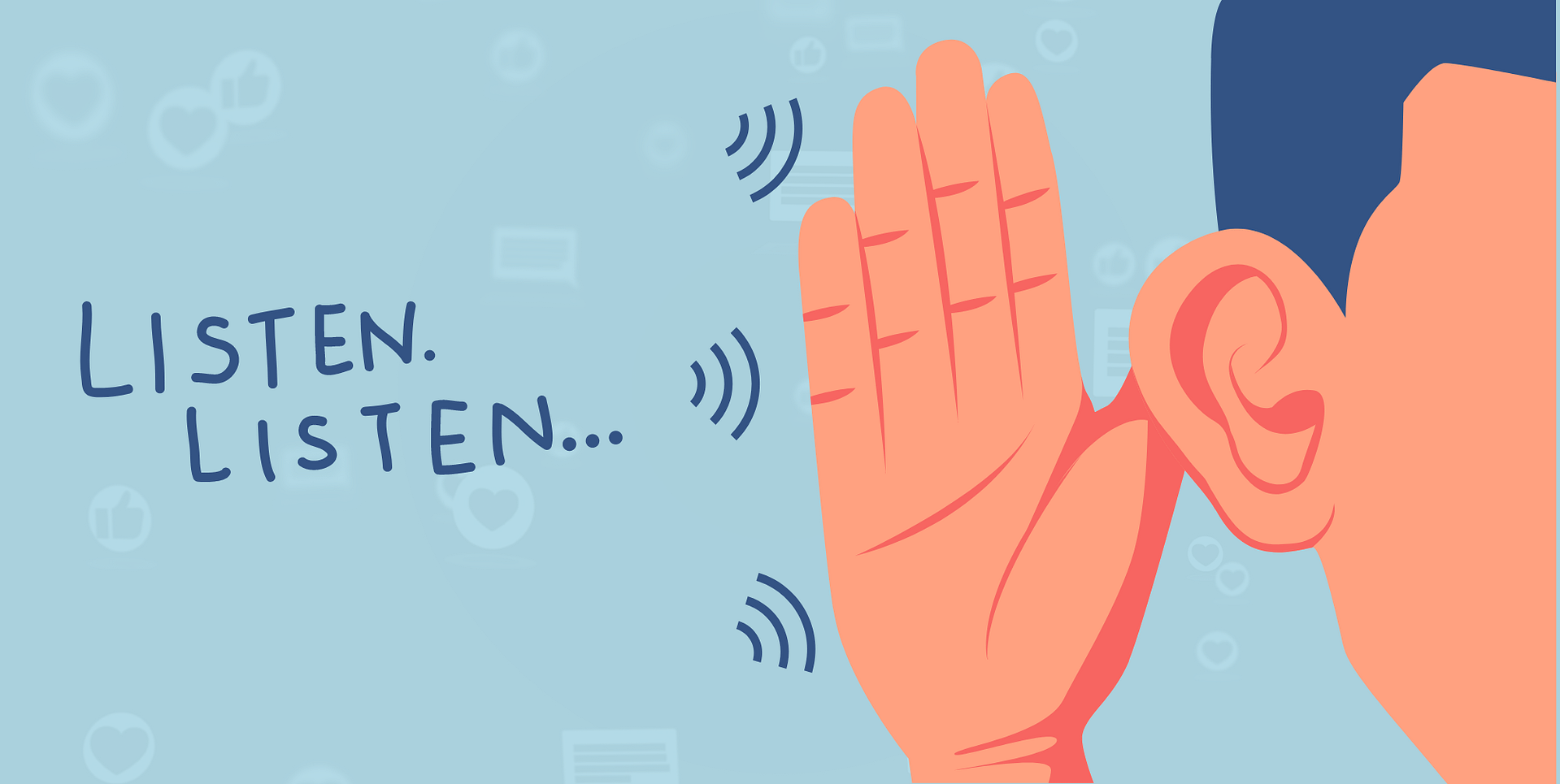In today’s digitally-connected world, it’s not enough to simply speak to your audience. You’ve got to listen to them, too. And no, we’re not just talking about replying to comments or messages.
We’re diving deep into the world of social listening. Stick around and we’ll uncover how this gem can help your small business punch well above its weight.
Table of Contents
- Understanding Social Media Marketing and Social Listening
- Setting up a Social Listening Strategy
- How to Implement Social Listening
- Case Studies: Successful Social Listening Strategies
- Common Challenges in Social Listening and How to Overcome Them
- Final Thoughts
- Get in Touch
Understanding Social Media Marketing and Social Listening
Before we jump into social listening, let’s take a quick detour. Remember, social media marketing is all about using social platforms like Facebook, Twitter, or Instagram to promote your products or services. It’s about building relationships, sparking conversations, and creating a community around your brand.
The Role of Social Listening in Social Media Marketing
Now, where does social listening fit into this picture? It’s like eavesdropping on those chatters about your brand. It involves tracking mentions of your brand, products, competitors, or industry trends, and then analyzing them to gain insights and take action.
It’s like having a superpower that lets you tune into the digital whispers about your brand.
The Connection and Differences Between Social Media Monitoring and Social Listening
Don’t mix up social media monitoring with social listening though. Yes, they are siblings, but not twins. Social media monitoring is about tracking and responding to direct interactions like comments, reviews, and direct messages.
On the other hand, social listening involves a more strategic, bigger-picture view. It helps you understand the overall sentiment about your brand and industry in the social sphere.
Setting up a Social Listening Strategy
Ready to get into the world of social listening? Great! Here’s a roadmap to get you started.
Identify Your Goals
First off, why do you want to use social listening? Your answer could be any or all of the following:
- Reputation management: Keep tabs on what people are saying about your brand.
- Customer engagement: Interact with customers in a more meaningful, personalized way.
- Competitive analysis: Get the dirt on what strategies your competitors are using.
- Market research: Understand your audience and their needs better.
Determine Your Target Audience and Platforms
Identify who you want to listen to and where they hang out. Are your customers more active on Twitter or Instagram? Do they participate in Reddit discussions or Facebook groups?
Knowing your audience is the key to any marketing strategy, and social listening is no different. Before you can listen, you need to know who you’re listening to. This is where your target audience comes into play.
Defining Your Target Audience
Your target audience is the group of people most likely to be interested in your product or service. These are the people whose problems you’re aiming to solve, and who you’re designing your offerings for.
You might have a good idea about who your audience is, but it’s essential to dig deep. Consider aspects like their age, gender, location, and socio-economic status. What are their interests and hobbies? What are their concerns and challenges? What are their goals and values?
Let’s say you own a small business that sells vegan cosmetics. Your target audience might be young, health-conscious women who are interested in cruelty-free products and sustainable living.
Identifying Your Platforms
Once you have a clear idea of who your target audience is, the next step is to figure out where they spend their time online. Each social media platform has its own demographic trends and types of content.
For instance, if your target audience is young adults, platforms like Instagram and TikTok might be your best bet. LinkedIn, on the other hand, might be a better choice if you’re targeting professionals.
If you’re unsure, start by examining the demographics of different platforms. Look at the age, gender, and interests of users on each platform. Surveys and polls can also be a good way to find out where your current customers spend their time online.
Additionally, don’t limit yourself to just the main social media platforms. Your audience might also participate in discussions on forums like Reddit or Quora, or in specific Facebook or LinkedIn groups. They might read blogs, watch YouTube videos, or use particular hashtags on Instagram or Twitter.
Choose the Right Social Listening Tools
With a slew of social listening marketing tools out there, find one that fits your needs and budget. Tools like Brandwatch, Mention, or Hootsuite offer a range of features to cater to small businesses.
Set Up Relevant Keywords and Phrases to Monitor
When setting up relevant keywords and phrases to monitor, it is important to consider the following:
- Your brand name: This is the most important keyword to monitor, as it will give you insights into how people are talking about your brand online.
- Your product names: If you sell multiple products, it is important to monitor the keywords associated with each product. This will help you track how your products are performing and identify any potential issues.
- Your competitors: It is also important to monitor the keywords associated with your competitors. This will help you stay ahead of the competition and identify any new opportunities.
- Industry-specific buzzwords: Finally, you may want to monitor industry-specific buzzwords. This will help you stay up-to-date on the latest trends in your industry and identify any potential opportunities.
By monitoring these keywords, you can gain valuable insights into how your brand is perceived online and identify potential issues or opportunities.
How to Implement Social Listening
Now that your strategy is in place, it’s time to put it into action.

Active Social Listening
Active listening is a two-way street. It involves not only hearing what the other person is saying but also understanding their perspective and responding in a way that shows you have been listening.
In the context of social media, active listening means responding to direct mentions of your brand.
This could mean replying to a comment on your Instagram post, addressing a customer complaint on Twitter, or interacting with a customer review.
When you actively listen to your customers, you show them that you care about their opinions and that you are committed to providing them with the best possible experience. This can lead to increased customer satisfaction, loyalty, and advocacy.
Here are some tips for active listening on social media:
- Be timely in your responses.
- Be respectful and professional.
- Be specific in your responses.
- Be helpful and informative.
- Be transparent and honest.
- Be open to feedback.
- Be patient.
Active listening is an essential part of any successful social media strategy. By taking the time to listen to your customers, you can build stronger relationships with them and create a more positive brand experience.
Passive Social Listening
Passive listening is the process of monitoring online conversations about your brand or industry without actively participating in them. This can be done by using social media listening tools, Google Alerts, and other online monitoring tools.
Passive listening can help you identify trends, opportunities, and threats in your industry. For example, if you notice a sudden surge in discussions around a particular topic in your industry, it could be a sign that there is a new trend emerging.
Or, if you realize that a new buzzword is being associated with your brand, it could be a sign that your brand is becoming more well-known.
Passive listening can be a valuable tool for businesses of all sizes. It can help you stay ahead of the curve and make informed decisions about your marketing and business strategy.
Competitive Analysis Using Social Listening
Who doesn’t want a sneak peek into their competitors’ strategies?

Competitive analysis is the process of identifying and analyzing the strengths and weaknesses of your competitors. This information can be used to develop strategies that will help you outperform your competitors.
Social listening is a tool that can be used to collect data about what people are saying about your competitors online. This data can be used to identify your competitors’ strengths and weaknesses, as well as their marketing strategies.
By monitoring your competitors’ social media activity, you can learn what they are doing well and what they are not doing so well. You can also use this information to identify opportunities to differentiate your business from your competitors.
Here are some of the benefits of using social listening for competitive analysis:
- You can identify your competitor’s strengths and weaknesses.
- You can learn from your competitors’ successes and mistakes.
- You can identify opportunities to differentiate your business from your competitors.
- You can track your competitors’ marketing strategies.
- You can stay ahead of the competition.
If you want to improve your business, social listening is a powerful tool that can help you gain a competitive advantage.
Measuring Sentiment and Analyzing Data
Remember, social listening is not just about collecting data, but analyzing it too. Use sentiment analysis to understand if the chatter about your brand is positive, negative, or neutral.
Case Studies: Successful Social Listening Strategies
Case Study 1: Customer Engagement
Consider Brand X, a small organic skincare brand. By actively listening on social media, they noticed customers raving about their face serum. They jumped into the conversation, interacted with customers, and created a user-generated content campaign around the product. Their engagement skyrocketed!
Case Study 2: Competitive Analysis
Then there’s Brand Y, a local coffee shop chain. They noticed customers of their competitor complaining about the lack of plant-based milk options. Seeing an opportunity, they started offering oat, almond, and soy milk and promoted it heavily on social media. The result? Happy customers and increased sales!
Common Challenges in Social Listening and How to Overcome Them
Social listening is not all sunshine and rainbows, though. It comes with its own set of challenges.
Information Overload
With millions of social media posts created every day, it’s easy to feel overwhelmed. Prioritize by focusing on platforms and keywords most relevant to your brand.
Addressing Negative Feedback
Not all chatter will be positive, but that’s okay. Negative feedback is a chance to learn and improve. Respond promptly and professionally, and turn unhappy customers into brand advocates.
Social Media Algorithm Changes
As platforms update their algorithms, your social listening strategy may need to adapt. Stay updated with changes and tweak your strategy as needed.
Privacy Concerns
With great power comes great responsibility. Be ethical in how you gather and use data, and always respect users’ privacy.
Maximizing the Benefits of Social Listening
Social listening offers a treasure trove of benefits.
Creating More Effective Marketing Strategies
By understanding your audience better, you can tailor your marketing strategies to their needs and preferences.
Building Brand Loyalty
When customers see that you’re listening and responding to their feedback, they’re likely to feel more connected to your brand.
Staying Ahead of Industry Trends
Keep an eye on broader trends in your industry, and be among the first to jump on new opportunities.
Final Thoughts
Social listening isn’t just a fancy buzzword, it’s a powerful tool that can help your small business thrive. So tune into the digital whispers about your brand, understand the sentiment behind them, and use these insights to grow your business.
After all, in the world of social media, listening can be just as powerful as speaking.




